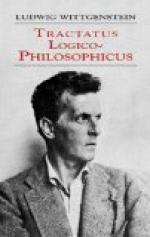3.4 A proposition determines a place in logical space. The existence of this logical place is guaranteed by the mere existence of the constituents— by the existence of the proposition with a sense.
3.41 The propositional sign with logical co-ordinates—that is the logical place.
3.411 In geometry and logic alike a place is a possibility: something can exist in it.
3.42 A proposition can determine only one place in logical space: nevertheless the whole of logical space must already be given by it. (Otherwise negation, logical sum, logical product, etc., would introduce more and more new elements in co-ordination.) (The logical scaffolding surrounding a picture determines logical space. The force of a proposition reaches through the whole of logical space.)
3.5 A propositional sign, applied and thought out, is a thought.
4 A thought is a proposition with a sense.
4.001 The totality of propositions is language.
4.022 Man possesses the ability to construct languages capable of expressing every sense, without having any idea how each word has meaning or what its meaning is—just as people speak without knowing how the individual sounds are produced. Everyday language is a part of the human organism and is no less complicated than it. It is not humanly possible to gather immediately from it what the logic of language is. Language disguises thought. So much so, that from the outward form of the clothing it is impossible to infer the form of the thought beneath it, because the outward form of the clothing is not designed to reveal the form of the body, but for entirely different purposes. The tacit conventions on which the understanding of everyday language depends are enormously complicated.
4.003 Most of the propositions and questions to be found in philosophical works are not false but nonsensical. Consequently we cannot give any answer to questions of this kind, but can only point out that they are nonsensical. Most of the propositions and questions of philosophers arise from our failure to understand the logic of our language. (They belong to the same class as the question whether the good is more or less identical than the beautiful.) And it is not surprising that the deepest problems are in fact not problems at all.
4.0031 All philosophy is a ‘critique of language’ (though not in Mauthner’s sense). It was Russell who performed the service of showing that the apparent logical form of a proposition need not be its real one.
4.01 A proposition is a picture of reality. A proposition is a model of reality as we imagine it.
4.011 At first sight a proposition—one set out on the printed page, for example—does not seem to be a picture of the reality with which it is concerned. But neither do written notes seem at first sight to be a picture of a piece of music, nor our phonetic notation (the alphabet) to be a picture of our speech. And yet these sign-languages prove to be pictures, even in the ordinary sense, of what they represent.




